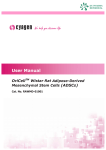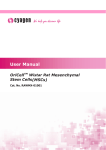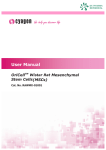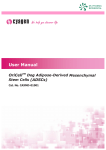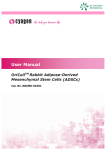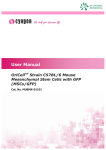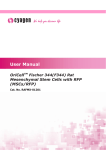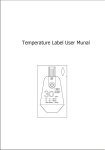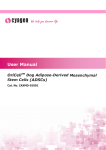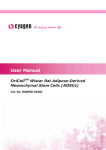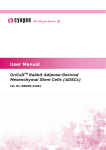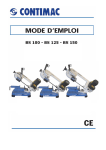Download User Manual
Transcript
User Manual OriCellTM Strain C57BL/6 Mouse Adipose-Derived Mesenchymal Stem Cells (ADSCs) Cat. No. MUBMD-01001 Table of Contents Contents and Storage ……………………………………………………………………………………… 3 Product Introduction …………………………………………………………………………………………3 Cell Characteristics and Identity …………………………………………………………………………3 Product Applications ……………………………………………………………………………………… 4 General Handling Principles ………………………………………………………………………………4 Culturing OriCellTM Strain C57BL/6 Mouse ADSCs Thawing and Establishing OriCellTM Strain C57BL/6 Mouse ADSCs ……………..…………… 4 Passaging Cyagen OriCellTM Strain C57BL/6 Mouse ADSCs ……………..……………… 6 Differentiation of OriCellTM Strain C57BL/6 Mouse ADSCs …………….………………… 8 Cryopreservation of OriCellTM Strain C57BL/6 Mouse ADSCs ………..………………… 12 Appendix ………………………………………………………………………………… 13 Troubleshooting ……………………………………………………………………………………………… 13 Related Products …………………………………………………………………………………………… 14 References …………………………………………………………………………………………………… 14 CONTENTS AND STORAGE Product Name Strain C57BL/6 Mouse AdiposeͲ Derived Mesenchymal Stem Cell Catalog No. MUBMDͲ01001 Amount per Vial 1×106 Cells Cryopreserved At Sixth Passage Storage Condition Liquid Nitrogen CAUTION: Please handle this product as a potentially biohazardous material. This product contains Dimethyl Sulfoxide (DMSO), a hazardous material, in the freezing medium. PRODUCT INTRODUCTION Adipose-Derived Mesenchymal Stem Cells (ADSCs) are multipotent stem cells that can differentiate into a variety of cell types, including osteocytes, adipocytes and chondrocytes. In addition, ADSCs have wide applications in tissue engineering, cell therapy and gene therapy. Cyagen OriCellTM Strain C57BL/6 Mouse ADSCs are derived from adipose tissue at inguen of qualified strain C57BL/6 mice. These cells express clusters of proteins specific for ADSCs and have a strong capacity for self-renewal while maintaining multipotency. In addition, these cells have been tested for: x Exogenous Factors: bacterial/fungal contamination, mycoplasma contamination, and endotoxin contamination. x Characteristics: post-thaw viability, cell cycle, verification of undifferentiated state, and differentiation potential. This product is intended for laboratory research use only. It is not intended for diagnostic, therapeutic, clinical, household, or any other applications. CELL CHARACTERISTICS AND IDENTITY x Strong capacity to expand. Can be passaged at least 3 times. IMPI0020A2MUBMDͲ01001Page3of14 x Multipotent diffferentiation n ability along osteogenic, chondrrogenic and d ogenic linea ages. adipo x Posittive for CD2 29, CD44, a and Sca-1 (> 70%), and a negativ ve for CD11 17 (<5%) in flo ow cytomettry assays. PRODUC CT APPL LICATIO ONS Adipose-Deriv ved Mesenchymal Stem m Cells (AD DSCs) have become a hot research target ntial use in regenerativ ve medicine and tissu ue engineerring (in area as such as for their poten cardiovascularr, neural an nd orthopae edic disease e). Cya agen OriCelllTM Strain C57BL/6 C Mo ouse ADSC Cs can be us sed as cell models to evaluate the e immunore eactions, prroliferation,, immigratio on and diffe erentiation of ADSCs both in vivo o d in vitro. and GENERA AL HAND DLING PRINCIP P PLES 1. Aseptic ha andling of th he product is necessary througho out. 2. Once the cells c have been b establlished, alwa ays freeze up several vials of AdiposeDerived Mesenchyma al Stem Cellls (ADSCs)) as a backu up. Notte: The OriiCellTM Strain C57BL/6 6 Mouse AD DSCs can be e frozen/th hawed at least one tim mes. 3. For genera al maintena ance of cell s, we recom mmend the e seeding d ensity to be 1.02.0×104ce ells/cm2. 4. For all stud dies, it is sttrongly reccommended d to use cells that are at, or unde er, an original pa assage num mber of 10. 5. For genera al maintena ance of cell s, we recom mmend tha at the medi um is chan nged if it becomes acidic a (the pH indicato or in culture e medium appears a yelllow). In ge eneral, change the m eve ery three da ays. e growth medium 6. Do not let Strain C57 7BL/6 Mousse ADSCs overgrow, as it will ressult in conta act inhibition. When the e cells are 8 80-90% con nfluent, sub bculturing tthe cells is strongly recommen nded. Notte: We stro ongly recom mmend the use of OriC CellTM cultu ure media a and other re elated rea agents for optimal o resu ults. THAWIN NG AND D ESTABLISHIN G OriCe ellTM STRA AIN C57 7BL/6 MOUSE M ADSCs Materials Required: x S C57B BL/6 Mouse Adipose-D Derived Mes senchymal S Stem Cells (Cat. No. OriCellTM Strain MUBMD-01 1001) IMPI0020A2M MUBMDͲ01001 Page4of14 x OriCellTM Mouse M Adipo ose-Derived d Mesenchy ymal Stem Cell Growtth Medium (Cat. No. MUXMD-90 0011) Tha awing and d Establish hing Mouse e ADSCs 1. Pre-warm OriCellTM Mouse M ADSC C Growth Medium M to 37°C. 3 2. M Add 9 mL of OriCellTM Mouse AD DSC Growth h Medium to a 15 mL conical tub be. 3. M Remove th he cryovial of OriCellTM Strain C5 57BL/6 Mouse ADSCs ffrom liquid nitrogen. 4. Quickly thaw the cryo ovial in a 3 37°C water bath until the t last ice crystal dis sappears. o finish the thawing prrocedure wiithin 3 minutes. Be ca areful not to o submerge e Be sure to the entire vial. Maxim mum cell vi ability is de ependent on the rapid d and comp plete thawing off frozen cells. Notte: Results s will be les ss than optiimal if the cells are th hawed for m more than 3 minutes. 5. As soon as s the cells are a comple tely thawed d, disinfect the outsid e of the via al with 70% % v/v ethano ol. 6. Use a pipe ette to trans sfer the cellls to the co onical tube containing g OriCellTM Mouse M ADSC Grow wth Medium m inside a b biosafety cabinet. Be careful nott to introduce any bubbles du uring the trransfer proccess. 7. Rinse the vial with 1 mL of the medium to reduce cell loss. Sub bsequently transfer pension into o the conica al tube. this 1 mL of cell susp 8. x the cell su uspension b by slowly pipetting p up p and down . Be carefu ul not to Gently mix introduce any bubble es. 9. Centrifuge e the cell su uspension a at 250 x g for f 5 minutes. 10. Carefully aspirate a offf as much o of the supernatant as possible an nd add 2-3 mL of fresh h OriCellTM Mouse M ADSC C Growth M Medium (pre-warmed to 37°C). 11. Gently re-suspend th he cells in O OriCellTM Mo ouse ADSC Growth Me edium. 12. Plate the cells c into a T25 flask a and add a sufficient s OriCellTM Mou use ADSC Growth G Medium. Gently G rock the culture e flask to evenly distribute the ce ells. 13. Incubate at a 37°C in a 5% CO2 h humidified incubator. 14. The next day, d change e the mediu um with fre esh growth medium (p pre-warmed d to 37°C).. 15. Change th he growth medium m eve ery three days thereaffter. 16. When the cells are ap pproximate ely 80-90% % confluent, they can b be dissociatted with 0.25%Trypsin-0.04% %EDTA and passaged. Notte: Changiing Mediu um 1. Warm an appropriate a e amount o f medium to t 37°C in a sterile con ntainer. Re eplace the spent med dium with the pre-warrmed, fresh h medium. Once comp pleted, retu urn the flask to the incubator. 2. eated warm ming and co ooling of the medium. If the entiire contentt is not Avoid repe needed forr a single procedure, p ttransfer on nly the requ uired volum me to a ster rile secondary y container.. IMPI0020A2M MUBMDͲ01001 Page5of14 PASSAGING OriCellTM Strain C57BL/6 Mouse NSCs/GFP Materials Required: Trypsin-Like Enzyme Solution Phosphate-Buffered Saline (1×PBS) (Cat. No. PBS-10001) OriCellTM Strain C57BL/6 Mouse Neural Stem Cells With GFP (Cat. No. MUBNF-01101) OriCellTM Neural Stem Cell Growth Medium (Cat. No. GUXNX-90011) Passaging Strain C57BL/6 Mouse NSCs/GFP 1. Pre-warm OriCellTM Neural Stem Cell Growth Medium, 1×PBS, Trypsin-Like Enzyme solution to 37°C. 2. Transfer the media containing the floating neurospheres to a 15 mL conical tube. 3. Centrifuge at 250 x g for 5 minutes. 4. Aspirate and discard all the supernatant and add 2mL of 1×PBS and 200μL of Trypsin-Like Enzyme to the conical tube and resuspend with a fire polished glass pipette. 5. Mechanically dissociate the neurospheres by gently pipetting up and down 8-10 times with a fire polished glass pipette, be careful not to introduce bubbles in the suspension. 6. Add 10 mL 1×PBS to the conical tube and mix well. 7. Centrifuge at 250 x g for 5 minutes. 8. Carefully aspirate off as much of the supernatant as possible. 9. Re-suspend the cells in 3 mL of OriCellTM Neural Stem Cell Growth Medium (prewarmed to 37°C). 10. Plate cells into two or three T25 flasks and add sufficient OriCellTM Neural Stem Cell Growth Medium. 11. Incubate the cells at 37°C in a 5% CO2 humidified incubator. Additional Tips Time to Split OriCellTM Strain C57BL/6 Mouse Neural Stem Cells With GFP When the neurospheres have a dark clump inside or ruffling on the outside of the neuro-sphere, it is recommended to split the cells. We typically split OriCellTM Strain C57BL/6 Mouse Neural Stem Cells With GFP every two days. OriCellTM Strain C57BL/6 Mouse NSCs/GFP DIFFERENTIATION Neural Stem Cells (NSCs/GFP) are maintained in serum-free culture medium supplemented with the mitogenes epidermal growth factor (EGF) and fibroblast growth factor 2 (FGF2). Removal of the mitogenes results in spontaneous differentiation of NSCs/GFP into neurons, astrocytes and oligondendroytes. Besides spontaneous differentiation, NSCs/GFP can be directly differentiated into those lineages in defined conditions. IMPI0065A1 MUBNF-01101 Page 6 of 10 ADSC Grow wth Medium m (6 ml forr T75 flask, 3 ml for T25 flask) to o neutralize e the trypsinizattion. 8. Gently pip pet the med dium over tthe cells to dislodge an nd resuspe nd the cells s. Repeat 5-6 times until all the e cells are d dissociated d from the flask f and ev venly dispe ersed into a single cell suspension n. 9. Transfer th he dissociated cells in to a 15 mL L conical tub be. 10. Centrifuge e at 250 x g for 5 minu utes to pelllet the cells s. 11. Carefully aspirate a offf as much o of the supernatant as possible. 12. Add 2 ml of o OriCellTM Mouse AD SC Growth Medium to o the conica al tube and d gently re-suspend th he cells tho oroughly. 13. Plate the cells c into ap ppropriate fflasks. OriC CellTM Strain n C57BL/6 Mouse ADS SCs can be split at 1:2 2 or other appropriate a e ratio. 14. Add an appropriate amount a of m medium to the cells. Incubate th e cells at 37°C 3 inside a 5% CO2 humidified incubator.. Notte: Care sh hould be tak ken to avoiid introduciing bubbles s during pip petting. Add ditional Tips T Tim me to Chan nge Mediu um It is s recomme ended to ch hange the cculture med dium if therre are too m many dead cells after pas ssaging. It is s recomme ended to ch hange the cculture med dium whene ever the m medium becomes acidic, eve en if the cells do not reach r 80-90 0% conflue ency. The pH p indicato or in the culture medium will appear a yello ow when accidic. In ge eneral, change the gro owth mediu um every ee days. thre me to Subc culture Tim T Strain C5 When OriCellTM 57BL/6 Mou use ADSCs s are 80-90 0% conflue nt, it is rec commended d ured. Do no ot let OriCe ellTM Strain C57BL/6 M Mouse ADSC Cs overgrow w that the cells be subcultu as iit will result in contactt inhibition.. P Passage 9-40x Fig.. 2 Images off OriCell TM Passa age 9-100x Stra ain C57BL/6 M Mouse Adipose e-Derived Mesenchymal Ste em Cells at pa assage 9. IMPI0020A2M MUBMDͲ01001 Page7of14 OriCellTTM STRAI IN C57B BL/6 MO OUSE AD DSCs DIFFEREN NTIATION TM USING O OriCell DIFFERENTIA ATION MEDIA M Cya agen OriCellTM ADSCs can differe entiate into a variety of o cell typess, including g osteocytes, adip cytes. pocytes and chondroc Osteogenic Differenttiation Materials Required: OriC CellTM Mese enchymal Stem S Cell O Osteogenic Differentiat D ion Medium m (Cat. No. GUXMX900 021) Ostteogenesis Protocoll otocol listed d below is ffor 6-well tissue t cultu ure plates. Notte: The pro 1. Culture the OriCellTM Starin C57 7BL/6 Mous se ADSCs in n OriCellTM M Mouse ADS SC Growth humidified incubator. Medium att 37°C in a 5% CO2 h 2. When cells s are appro oximately 8 80-90% con nfluent, they can be diissociated with w 0.25%Trypsin-0.04% %EDTA (Catt. No. TEDT TA-10001). 3. Reseed the e OriCellTM Starin C57 7BL/6 Mouse ADSCs in n the growtth medium at 4 3×10 cells s/cm2 in a 6-well 6 tissu ue culture with w a medium volume e of 2 mL per p well. 4. Incubate the t cells at 37°C in a 5 5% CO2 hu umidified incubator. 5. When cells s are appro oximately 6 60-70% con nfluent, carefully aspirrate off the growth medium frrom each well w and add d 2 mL of OriCellTM O Mesenchyma M al Stem Cell Osteogenic Differentiiation Medi um (pre-wa armed to 37°C). 6. Feed cells every 3 da ays for 2-3 weeks by completely c replace the e medium with w fresh OriCellTM Mesenchym M ell Osteogen nic Differen ntiation Med dium. al Stem Ce 7. After 2-3 week w differentiation, ccells can be e fixed and stained witth Alizarin Red S. vent osteoblasts from detaching, it is recom mmended to o change ha alf of the Notte: To prev med dium every y two days before b anallysis. Aliz zarin Red Stain Ana alysis 1. c have differentiate d ed, remove e the osteog genic differrentiation medium m After the cells from the wells w and rinse with 1x x phosphatte-buffered saline (PBS S). Fix cellls with 2 mL of 4% formaldehy yde solutio n for 30 minutes. 2. Rinse wells s twice with h 1x PBS. S Stain the ce ells with 1 mL alizarin red S working s solution forr 3-5 minuttes. 3. Rinse wells s 2-3 times with 1x PB BS. 4. C Cells can now be visualized and analyzed under u a mic croscope. IMPI0020A2M MUBMDͲ01001 Page8of14 Fig g. 3 OriCell TM Strain C57BL//6 Mouse Adip pose-derived Mesenchymal Stem Cells a re differentiatted into Osteocytes O and d are stained with Alizarin Red R S. Adipogenic Differenttiation Materials Required OriC CellTM Mese enchymal Stem S Cell A Adipogenic Differentia ation Mediu um (Cat. No. N GUXMX X900 031) Adiipogenesis s Protocoll otocol listed d below is ffor 6-well tissue t cultu ure plates. Notte: The pro 1. Culture the OriCellTM Strain C57 7BL/6 Mous se ADSCs in n the OriCe llTM Mouse ADSC edium at 37 7°C in a 5% % CO2 humidified incubator. Growth Me 2. When cells s are appro oximately 8 80-90% con nfluent, they can be diissociated with w 0.25%Trypsin-0.04% %EDTA (Catt. No. TEDT TA-1000). 3. Reseed the e ADSCs in n growth me edium at 2x104 cells/c cm2 in a 6--well tissue culture plate with a medium m volume o of 2 mL perr well. 4. Incubate the 5% CO2 hu t cells at 37°C in a 5 umidified incubator. 5. Feed the cells c every three t days until they are 100% confluent o or post-confluent. Induction of adipogen nic differen ntiation at post-conflue p ency is stro ongly recom mmended. 6. When the cells are 10 00% conflu uent or post-confluentt, carefully aspirate offf the spentt growth me edium from m the wells a nchymal Ste em Cell and add 2 mL of OriCellTM Mesen Adipogenic c Differentiation medi um A (induction med dium) per w well. 7. TM Three days later, cha ange the m edium to OriCell O Me esenchymall Stem Cell Adipogenic c ation mediu um B (main ntenance medium) by completely y replacing the spent Differentia medium A. A 8. 24 hours later, chang ge the med dium back to t MSC Adip pogenic Diffferentiation n medium A. A 9. To optimally differenttiate ADSC s into adipo ogenic cells s, repeat th he cycle of induction and maintenance thrree times. 10. After three e to five cycles of indu uction and maintenanc ce, culture the cells in n OriCellTM Mesenchym mal Stem Cell C Adipoge entiation medium B fo or an additio onal 4-7 enic Differe days until the lipid drroplets are big, round enough. During D these e days period, change e IMPI0020A2M MUBMDͲ01001 Page9of14 the medium every three days. Oil Red O Stain Analysis 1. After the cells have differentiated, remove the MSC Adipogenic Differentiation Medium from the wells and rinse with 1x phosphate-buffered saline (PBS). Fix cells with 2 mL of 4% formaldehyde solution for 30 minutes. 2. Rinse wells twice with 1x PBS and stain cells with 1 mL of oil red O working solution (3:2 dilution with distilled water and filter with filter paper) for 30 minutes. 3. Rinse wells 2-3 times with 1x PBS. 4. Cells can now be visualized and analyzed under a microscope. Fig.4 OriCell TM Strain C57BL/6 Mouse Adipose-derived Mesenchymal Stem Cells are differentiated into adipocytes and are stained with Oil Red O. Chondrogenic Differentiation Materials Required: OriCellTM Mesenchymal Stem Cell Chondrogenic Differentiation Medium (Cat. No. GUXMX90041) Chondrogenesis Protocol: 1. Calculate the total number of ADSC pellet cultures required for your experiment (2.5×105 ADSCs are needed to form each chondrogenic pellet). Transfer this amount of cells into an appropriate culture tube. 2. Wash the ADSCs with Incomplete Chondrogenic Medium. Centrifuge the cells at 150 x g for 5 minutes at room temperature, and then aspirate off the supernatant. Resuspend the cells in 1 mL of Incomplete Chondrogenic Medium per 7.5×105 cells. Centrifuge again at 150 x g for 5 minutes, and then aspirate off the medium. 3. Resuspend the ADSCs in Complete Chondrogenic medium to a concentration of 5.0×105 cells/mL. 4. Aliquot 0.5 mL (2.5×105 cells) of the cell suspension into 15 mL polypropylene IMPI0020A2MUBMDͲ01001Page10of14 culture tub bes. Centrifuge the ce ells at 150 x g for 5 minutes m at rroom temperature. T aspirate the t superna atant or res suspend the pellet. Notte: DO NOT 5. d incubate the tubes Loosen the e caps of th he tubes in order to allow gas ex xchange and at 37°C in a humidified atmosph % CO2. Do not n disturb the pellets s for 24 here of 5% hours. 6. c pellets every e 2-3 d days by com mpletely re eplacing the e medium in each tube e Feed the cell (to avoid aspirating a the t pellets w when aspirrating the medium, m atttach a sterile 1-200NjL L pipette tip p to the end d of the asp pirating pipette). Add 0.5 mL of freshly pre epared Complete Chondroge enic Medium m to each tu ube. 7. After repla acing the medium, m flicck the botto om of the tu ube to ensu ure that the e pellet is free floatin ng. Loosen n the caps a and return the tubes to t the 37°C C incubator. 8. Chondroge enic pellets should be harvested after 14-28 8 days in c ulture. Pellets may be e formalin-fiixed and pa araffin-emb bedded for alcian blue stain analy ysis. Alc cian Blue Staining S Procedure 1. The tissue e sample sh hould be forrmalin-fixed d and parafffin-embed ded already. 2. Staining procedure: a) Depara affinize slide es and hyd rate to disttilled water. b) Stain in n alcian blue solution ffor 30 minu utes. c) Wash in n running tap water fo or 2 minute es. d) Rinse in n distilled water. w nalysis. Blue staining e) Visualiz ze under a light micro oscope and capture im mages for an g indicates synthesis of proteo oglycans by y chondrocy ytes. F Fig.5 OriCell TM Strain C57BL L/6 Mouse Adi pose-Derived Mesenchymal Stem Cells a are differentia ated into chondrocytes and are stain ned with Alcian n Blue. IMPI0020A2M MUBMDͲ01001 Page11of14 4 CRYOPR RESERVA ATION OF O OriC ellTM STRAIN C5 57BL/6 MOUSE E ADSCs OriCellTM NCR R Protein-F Free Cryoprreservation Medium (C Cat. No. NC CPF-10001) is a use freezing g medium. Its chemically-define ed and prottein-free prrotein-free,, ready-to-u fo ormulation has h been optimized to o stem cells s and prima ary cells, th hus greatly enhancing he viability and integrity of these cells by prrotecting th hem from da amage durring the th on ne-step free p Unlike other conventiional freezi ng media, which eze-thaw procedure. re equire a slow programmed freeze e, this prod duct allows the cells to o be directly y frozen at -8 80°C. Cryopreservation m with fres sh growth medium m 24 hours befo N Note: Change the cultture medium ore freezing g. 1 1. Collect cells that are a in the lo ogarithmic growth pha ase. Perforrm a cell co ount to ble cell den nsity. determine the viab 2 2. Centrifu uge the cells for 3-5 m minutes at 250 2 x g and d 20°C. Re move and discard the e superna atant using a pipette. 3 3. Resuspend the celll pellet in tthe OriCellT TM NCR Pro otein-Free C Cryopreserv vation m at a cell density d of 1 105-106 cells/mL. Medium 4 4. Dispens se aliquots of the cell suspension n into cryog genic storag ge vials tha at are properly y labeled. 5 5. Place th he vials dire ectly in a -8 80°C freeze er. After 24 hours, tra ansfer the frozen vials s to liquid d nitrogen for f long-terrm preservation. IMPI0020A2M MUBMDͲ01001 Page12of14 4 APPE NDI X Cell aging Platingdensityistoolow Somestemcellscansecretefactorsto supportcellgrowth.Therefore,acertain degreeofplatingdensitymustbe maintained;otherwise,itwillleadtocell Troubleshooting The table below lists some potential problems and solutions for culturing ADSCs. Problem Low cell recovery rate Slow cell growth Cause Solution Thestorageconditiondoes notmeettherequirements Purchaseareplacementandstoreinliquid nitrogenforlongͲtermpreservation. Thawingofthecellstakestoo long Thawcellsfornomorethan3minutes. Cellsareincompletely recoveredafterthawing Afteraspiratingoffmedium,washthe tubewithculturemediumtwiceand transferallofthecellstothedish. Cellsarehandledroughly Careshouldbetakentoavoidintroducing bubblesduringpipetting.Alsoavoid vortexingandhighͲspeedcentrifugation MediumisnotpreͲwarmed Warmmediumto37°Cbeforerecovery. Mycoplasmacontamination Discardthecellsinquestionanddisinfect thelaboratoryenvironmentbefore recoveringthenextbatchofcells. Overdigestion WashthecellswithPBS2Ͳ3timesto removeserumpriortotrypsinization(serum willinhibitthefunctionoftrypsin). Controlthe digestiontime. Cell aging Platingdensityistoolow Increasetheplatingdensity. Inappropriateserumand medium UseCyagentailorͲmadeculturemedia. If otherserumandmediaproductsareused, pleaseperformvalidationtoensure compatibility. Deadcellsarenotremoved promptly Changethemediumthenextdayafter recoverytoensureremovalofalldead cells. CellContamination Discardthecellsinquestionanddisinfect thelaboratoryenvironmentbefore recoveringthenextbatchofcells. IMPI0020A2MUBMDͲ01001Page13of14 ƉƌŽůŝĨĞƌĂƟŽŶ slow ĚŽǁŶ ĂŶĚ cell agŝŶg. Over ĚŝŐĞƐƟŽŶ Wash the cells with PBS 2-3 ƟŵĞƐ to reŵove ƐĞƌƵŵ prior to tryƉƐŝŶŝzaƟoŶ ;ƐĞƌƵŵ will ŝŶŚŝďŝƚ the ĨƵŶĐƟŽŶ of trypsŝŶ). CoŶtrol the diŐĞƐƟoŶ ƟŵĞ͘ Cells show spontaneous ĚŝīĞƌĞŶƟĂƟŽŶ /ŶĞīĞĐƟǀĞ ŝŶĚƵĐƟŽŶ of Đell ĚŝīĞƌĞŶƟĂƟŽŶ The passagiŶŐ Ɵŵe is ŶŽt appropriate The cells should ďĞ ƐƵďĐƵůƚured ǁŚĞŶ rĞĂĐŚŝŶŐ 80-90% cŽŶŇƵĞŶĐLJ iŶ order to avoid coŶtact ŝŶŚŝďŝƟŽŶ͘ DMSO is ŶŽt coŵpletely ƌĞŵŽǀĞĚ ĚƵƌŝŶŐ cell recovery Wash the cells with pre-warŵed ŵĞĚŝƵŵ 2-3 ƟŵĞƐ duriŶŐ recovery. ŝīĞƌĞŶƟĂƟŽŶ ƌĞĂŐĞŶƚƐ Ŷeed to ďĞ opƟŵized Cell passage is too high Use CyagĞŶ tailor-ŵĂĚĞ diīereŶƟaƟŽŶ ŵĞĚŝĂ͘ Use cells at a low ŽƌŝŐŝŶĂů passage ŶƵŵďĞƌ͘ Related Products Product Catalog Number OriCellTM Mouse Adipose-Derived Mesenchymal Stem Cell Growth Medium MUXMD-90011 OriCellTM Mesenchymal Stem Cell Osteogenic Differentiation Medium GUXMX-90021 OriCellTM Mesenchymal Stem Cell Adipogenic Differentiation Medium GUXMX-90031 OriCellTM Mesenchymal Stem Cell Chondrogenic Differentiation Medium GUXMX-90041 0.25%Trypsin-0.04%EDTA TEDTA-10001 Phosphate-Buffered Saline (1xPBS) PBS-10001 OriCellTM NCR Protein-Free Cryopreservation Medium NCPF-10001 References JM Gimble, and F Guilak. (2003) Adipose-derived adult stem cells: isolation, characterization, and differentiation potential. ISCT 5: 362-369. Cyagen Biosciences reserves all rights on the technical documents of its OriCellTM cell culture products. No part of this document may be reproduced or adapted for other purposes without written permission from Cyagen Biosciences. 大日本住友製薬グループ 〒564-0063 大阪府吹田市江坂町2丁目1番43号 KYUHO江坂ビル8階 (在庫・納期・発送等) TEL:06-6990-8051 FAX:06-6325-6058 (テクニカルサポート) TEL:072-636-8160 FAX:072-634-7222 http://www.dspbio.co.jp/ [email protected] IMPI0020A2 MUBMD-01001 Page 14 of 14















